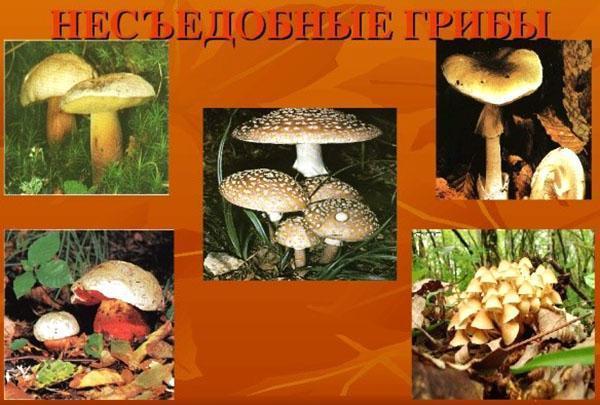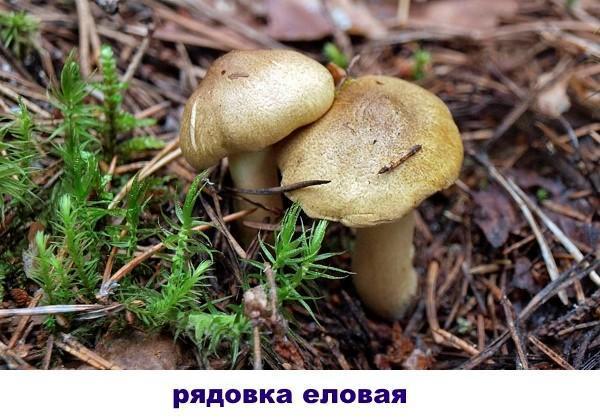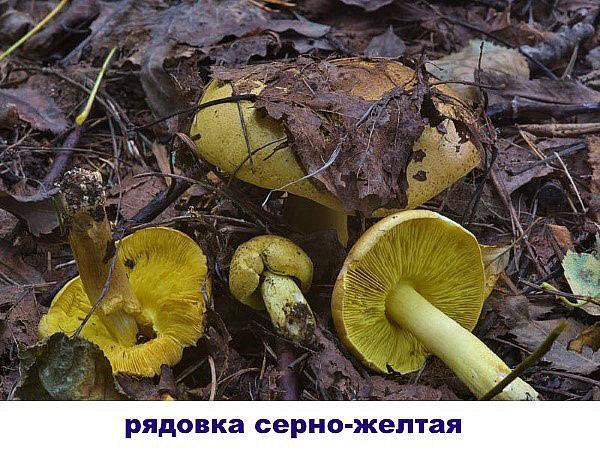Need to Know: All About Inedible Mushrooms
 Experienced mushroom pickers know that among the forest gifts there are specimens that will not bring harm, but will not bring pleasure either. We are talking about inedible mushrooms. They have nothing to do with poisonous species, however, it is also impossible to eat such a "harvest". This category includes mushrooms, the pulp of which does not contain dangerous toxins to cause severe poisoning, but at the same time has a combination of signs or one of them:
Experienced mushroom pickers know that among the forest gifts there are specimens that will not bring harm, but will not bring pleasure either. We are talking about inedible mushrooms. They have nothing to do with poisonous species, however, it is also impossible to eat such a "harvest". This category includes mushrooms, the pulp of which does not contain dangerous toxins to cause severe poisoning, but at the same time has a combination of signs or one of them:
- very rigid structure;
- unpleasant taste (most mushrooms are very bitter);
- a disgusting smell, which can be present either in the raw mushroom, or manifests itself in the process of its preparation.
Some species, in addition to the description listed, have ugly growths on the caps.
We bring to your attention a short list of the most famous inedible mushrooms with a name, description and photo. We hope it will help you avoid annoying mistakes and choose only the most delicious mushrooms.
Resident of coniferous forests - Ryadovka
Ryadovka mushrooms belong to one of the species, the variety of which can confuse even an experienced mushroom picker. In addition to delicious edible and frankly dangerous poisonous, there are also inedible rows. The most famous of them:
- The row is spruce. Grows in damp thickets of conifers and firs. The cap is small, up to 10 cm in diameter, similar to a light brown bell with a slight bulge in the center. The surface is covered with barely noticeable scales and stripes, and in overripe mushrooms, the caps crack, revealing a light, watery pulp with a very pungent taste and unpleasant odor. The leg is rather high, curved, empty inside.

- The row is sulfur-yellow. Found in deciduous and coniferous forests. Young mushrooms have rounded caps of a sulfur-yellow color, in old ones they level out, and a bulge forms in the center, and the color darkens. After rain, the skin becomes slippery; in dry weather, however, it is smooth, velvety. The slender leg in the upper part is bright yellow, thickened or tapering, and closer to the ground it becomes more dirty in color. The legs of old mushrooms are decorated with dark scales, but not always. The pulp is yellow-green, smells like acetone, bitter.

Young spruce rows can be confused with conditionally edible greenfinches, but, unlike the first ones, greenfinches grow on a short fleshy stalk and green predominates in color.
Some scientists attribute the spruce and sulfur-yellow ryadovka to poisonous. Indeed, when eating them, you can get a mild eating disorder, but a small amount of toxins is usually not fatal.
Russula beauties or appearances are deceiving
Among the russula known to all, most mushrooms are considered edible and very tasty, and some especially risky mushroom pickers even use them without prior boiling. At the same time, there are varieties among them that even the most desperate eater will not dare to taste, and the reason lies in the pungent taste.
Inedible russula, which, however, are very beautiful in appearance, include:
- Caustic (it is vomit or burning-caustic). On a white brittle leg, empty inside, flaunts a convex bright pink cap with lighter edges, covered with a sticky skin. There are also red or purple colored mushrooms. The pulp is white, thin and friable, odorless, but very bitter.

- Blood red (aka sardonyx). It also has a red cap in different variations of this color, but differs in a pink fleshy leg in the form of a club or cylinder. The edges of the cap are slightly wavy, the skin is glossy, well removable. The pulp is white, dense, pungent in taste and does not smell anything.

- Spicy. A very bright and noticeable mushroom, which certainly cannot be passed by: a cap of a deep purple color with a darker center, first convex, and then smoothed out. The smooth leg is dark pink. The pulp and plates are yellow. The taste is very pungent.

- Birch. One of the most bitter russula, the pungent taste does not disappear even after prolonged soaking. But it looks pretty attractive and even smells delicious, like fruit, with a hint of honey. The leg is white, the cap is beige, the pulp is light and fragile.

Even a lump is tasteless
Many novice mushroom pickers think that milk mushrooms can be collected and eaten everything and then sincerely wonder why an appetizing-looking mushroom cut under a birch turns out to be bitter. This happens if you come across inedible milk mushrooms, which are also called milkmen for their viscous milky juice released during a break.
Inedible milkmen include:
- Thorny. The mushroom is medium in size with a slightly convex or outstretched cap with uneven edges, the color varies from pink to light brown. In older specimens, reddish flaking scales, resembling small thorns, often form on the surface of the cap. A hollow leg of the same color, curved, yellow plates under the cap are firmly attached to it. The flesh of this inedible mushroom is yellowish or greenish, odorless, but very pungent.

- Sticky (aka gray-green or slimy). The name is quite consistent with the appearance: the light leg sticks to the hands, on top it is decorated with a dirty green, even gray, hat with dark spots. Also sticky and milky juice that flows out when fragile, white and sharp, odorless pulp is broken.

- Hepatic. Small mushrooms are completely colored in a beautiful brown color, the cap is slightly funnel-shaped, smooth. The pulp is also brown, but lighter, very fragile, odorless, disgustingly pungent.

- Golden yellow (aka golden). The cap is concave, smooth, reddish-golden in color, with darker thin stripes or spots. The leg is slightly lighter, at first dense, then it becomes hollow. The pulp and juice are white, but turn yellow when cut. There is no frightening aroma, but the mushroom tastes very bitter. In shape, the milky is similar to camelina, but the latter has orange juice with a transition to a greenish tint.

- Gray-pink (aka amber or roan). The funnel-shaped hat and stem are tinted dirty pink, closer to brown. White-pink plates under the cap are firmly attached to the loose stem. A characteristic feature of such a lump is a sharp unpleasant odor emanating from the yellowish pulp and resembling lovage or chicory.

- Resinous black (aka resinous). The hat is chocolate brown with a velvet surface, almost flat. The sturdy leg has the shape of a cylinder with an extension at the top and is covered with a light downy. The pulp and juice are white, but turn pink when cut. Interestingly, despite the bitter taste, the mushroom has a pleasant fruity aroma.

According to some sources, the sticky milky belongs to poisonous mushrooms: a large amount of toxins can cause severe poisoning.
Beautiful but bitter boletus
Among the handsome boletus mushrooms there are such "comrades" who, even after long cooking, do not become tasty. Their dense pulp contains a lot of bitterness, making them completely unusable.
Inedible boletus includes:
- Handsome (he is beautiful-footed or simply inedible). The mushroom body is characteristic of the species and is very fleshy, the cap is brown in color, covered with dry skin. The whole leg is pink-red or yellowish with a pink mesh.The creamy bitter flesh turns blue when cut.

- Stocky (aka rooted or bitter spongy). The hemisphere-shaped hat is off-white, smooth, often cracked. A lemon-colored leg with a light mesh, at the ground has a thickening in the form of a tuber. The pulp is also yellow, turns blue when pressed, odorless, bitter.

Inhabitant of meadows chlorophyllum lead-slag
 This inedible mushroom with a difficult name looks like an umbrella, and some scientists classify it as a poisonous species. The completely toxic properties of lead-slag chlorophyllum have not yet been fully studied, therefore, today it is still classified simply as an inedible mushroom.
This inedible mushroom with a difficult name looks like an umbrella, and some scientists classify it as a poisonous species. The completely toxic properties of lead-slag chlorophyllum have not yet been fully studied, therefore, today it is still classified simply as an inedible mushroom.
In order to avoid possible eating disorders, it is better not to risk and not touch the mushrooms encountered during the walk.
Mushrooms have a head like an umbrella. In older specimens, it is prostrate, but in youth it has a bell-shaped shape. The hat is painted gray-white with a small tubercle in the center, which is darker. The skin on the surface of the cap of lead-slag chlorophyllum is dry, with the remains of the bedspread. The high leg is thin, white, but turns brown when broken. In young mushrooms, it is decorated with a ring on top. The pulp is white, turns pink on contact with air.
Fragile stump-lover alder scale
 On the rotten remains of tree species at the end of summer, you can find small mushrooms with brittle pulp - alder flakes. The ocher-yellow cap in the center has a darker color, and at the edges there are the remains of the bedspread. The brownish stem is first ringed, but then becomes smooth. The yellow pulp breaks easily and tastes very bitter.
On the rotten remains of tree species at the end of summer, you can find small mushrooms with brittle pulp - alder flakes. The ocher-yellow cap in the center has a darker color, and at the edges there are the remains of the bedspread. The brownish stem is first ringed, but then becomes smooth. The yellow pulp breaks easily and tastes very bitter.
For its fiery color, the mushroom is also called the alder moth.
Earthen inhabitant of Gebeloma tapered
 The one who definitely cannot be confused with other mushrooms is the tapered hebele, and all due to the fact that its long gray leg, covered with small brownish scales, is half hidden in the ground. But the hat is rather small, at first it is semicircular, then it is aligned. The skin is shiny, light brick, with ingrown scales. The flesh of young gebeloma is sweet, but then the sweetness leaves, giving way to bitterness. It has no doubles, because of its taste, it is not used for food.
The one who definitely cannot be confused with other mushrooms is the tapered hebele, and all due to the fact that its long gray leg, covered with small brownish scales, is half hidden in the ground. But the hat is rather small, at first it is semicircular, then it is aligned. The skin is shiny, light brick, with ingrown scales. The flesh of young gebeloma is sweet, but then the sweetness leaves, giving way to bitterness. It has no doubles, because of its taste, it is not used for food.
The smallest mushroom - meat askokorine
 Violet-lilac fleshy growths on trunks and stumps, it turns out, are also mushrooms called ascocorine meat. Indeed, in color they resemble fresh meat. The mushrooms themselves are very small, no more than 1.2 cm, at first they grow one by one, but quickly merge into a solid dense carpet. The shape of an adult mushroom is varied: it can have a funnel in the center of the shiny cap, or it can be convex. The numerous family of inedible ascocorine mushrooms, growing on a tree, looks like a multi-tiered outgrowth, while each next "floor" has grown tightly to the previous one. The mushrooms also have legs, but they are very small, less than 1 cm. Although the pulp of mushrooms does not have a bitter taste or unpleasant odor, they are considered to be inedible due to their miniature size, which is rather difficult to process before cooking.
Violet-lilac fleshy growths on trunks and stumps, it turns out, are also mushrooms called ascocorine meat. Indeed, in color they resemble fresh meat. The mushrooms themselves are very small, no more than 1.2 cm, at first they grow one by one, but quickly merge into a solid dense carpet. The shape of an adult mushroom is varied: it can have a funnel in the center of the shiny cap, or it can be convex. The numerous family of inedible ascocorine mushrooms, growing on a tree, looks like a multi-tiered outgrowth, while each next "floor" has grown tightly to the previous one. The mushrooms also have legs, but they are very small, less than 1 cm. Although the pulp of mushrooms does not have a bitter taste or unpleasant odor, they are considered to be inedible due to their miniature size, which is rather difficult to process before cooking.
Going into the forest, remember that the external beauty of the mushroom can be deceiving, and can deliver at least grief. Carefully study the pictures of inedible mushrooms selected in the article before the trip. Be careful and carefully choose only edible mushrooms, and in case of the slightest doubt it is better to return home empty-handed than to bring frankly unpleasant surprises. Have a good hunting"!